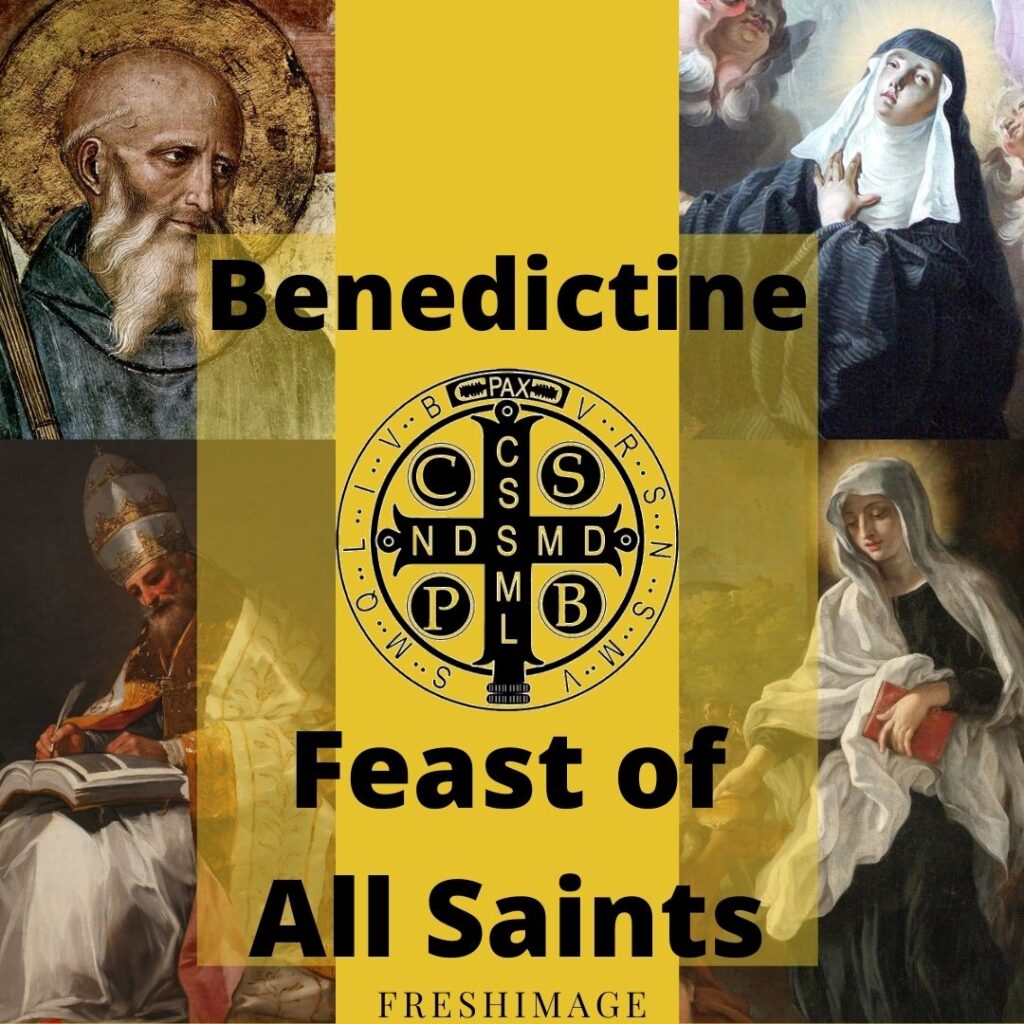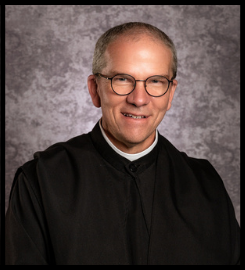
Indeed, He sent the Holy Spirit upon all men that He might move them inwardly to love God with their whole heart and their whole soul, with all their mind and all their strength and that they might love each other as Christ loves them (Lumen Gentium, Ch. 5).
Today we continue to celebrate the heroes of the Church with the celebration of All Saints of the Order of Saint Benedict.
Throughout the month of November, we’ve reflected on several saints of the Roman Rite. Throughout the year the Church tries to remember the thousands of holy men, women, and children raised to the altar as saints. These saints have come from all parts of the world, various backgrounds, and exemplify various virtues and devotion to the sacraments of the Church. These holy friends are listed and assigned throughout the year on what the Church calls the Liturgical Calendar.
The Church’s Liturgical Calendar remembers many saints with whom we’re all familiar. However, there are even more saints of the Church than one calendar can handle. In addition to the Church’s regular Liturgical Calendar, there are specific ordos followed by different archdioceses and diocese. The ordo is an annual calendar giving directives for the celebration each day’s Mass and Divine Office. Each diocese, group of dioceses, and religious order and congregation has its own ordo. The ordo serves as a kind of supplement to the Liturgical Calendar of the Roman Rite of the Universal Church.
The Liturgical Calendar is where saints and other celebrations are distinguished by their rank and assigned a Solemnity, Feast, or Memorial. Sundays are always ranked as Solemnities because they commemorate the Lord’s Resurrection. For Solemnities the celebration begins the evening before the feast with the office of First Vespers. The celebration of Feasts and Memorials are celebrated over one day. Memorials are assigned to be either obligatory or optional; depending on the region in which the saint is being celebrated. A celebration may be elevated to a feast or solemnity according to the particular relationship a saint has to a community. For example, in the Archdiocese of Saint Louis the ordo will recognize particular saints with the rank of a Feast or Solemnity, or may even recognize a saint no other diocese would celebrate. Thus, King Saint Louis IX and Saint Rose Philippine Duchesne are ranked as a feast due to their unique connection to our Archdiocese, whereas they are optional memorial celebrations in the General Roman Calendar.
Holy days of obligations are the great feasts of the Church’s year when the faithful are obligated to honor these holy men and woman at the Holy Eucharist. There’s also the observance of abstaining from unnecessary labor or other activities on these days as well. There are six Solemnities in the United States, which are obligatory feasts: Mary, Mother of God, Ascension Thursday, Assumption of the Mary, Immaculate Conception, and the Nativity of Our Lord.
So, why does the Church celebrate this vast array of personalities that served the Lord in love throughout the world? We see in the saints the universality of the Church. Not only their numerous backgrounds, gifts, nationalities, and charisms. Included in this vast multitude are saints who span beyond the regular calendar of the Roman Rite. Saints many of us may have never heard of. These are represented in the ordos of the various religious orders and congregations in the Church. The Dominicans, Franciscans, Jesuits, Redemptorists, and of course the Benedictines.
In these ordos congregations have their own celebrations to observe. One of these congregation of religious is the Benedictine Confederation. The term confederation is used to distinguish the way in which Benedictines are governed compared to other religious congregations. This list of saints and their ranking can change according to the community and where the community originates within the Benedictine Confederation.
The Abbey of Saint Mary and Saint Louis was founded from Ampleforth Abbey in Yorkshire, England. So, we’re honored to belong to the English Benedictine Congregation because of our English roots. There are two other major congregations of Benedictines in the United States; the Swiss-American Congregation and the American Cassinese Congregation.
The English Benedictine Congregation has its own ordo, which is published each year. In it you’ll find many unique saints from England and Whales. On this day when we celebrate the great saints of Saint Benedict, we offer a look into the extraordinary lives of these heroes from across the pond.
Saint Alban Roe was a monk and priest of Ampleforth Abbey in Yorkshire, England. After the dissolution of the monasteries the monks were scattered across England. Saint Alban Roe went on the mission to London. He was arrested for being a Catholic priest and was exiled and imprisoned off and on until his martyrdom at Tyborn in 1642 by being hanged, drawn, and quartered. You can do further research to know what that means. In short, it was quite brutal. Saint Alban was quite the personality and was even known to play cards and play jokes on his captors. Saint Alban exemplified great zeal to bring souls to Christ and to offer the Holy Eucharist. At his martyrdom Saint Alban exclaimed, My Saviour has suffered far more for me than all that; and I am willing to suffer the worst of torments for his sake.
Saint Alban Roe was canonized as one of the Forty Martyrs of England and Whales by Pope Saint Paul VI in 1970. In addition to Saint Alban some other Benedictine martyrs are Blessed John Beche, Abbot of Colchester, 1 December 1539, Blessed Hugh Faringdon, Abbot of Reading, 14 November 1539, Blessed Richard Whiting, Abbot of Glastonbury, 15 November 1539, Blessed John Rugg, 15 November 1539, Blessed John Thorne, 15 November 1539. Saint John Roberts, 10 December 1610, Blessed Mark Barkworth, 27 February 1601, Blessed George Gervase, 11 April 1608, Blessed Maurus Scott, 30 May 1612, Blessed Philip Powell.
There are many miracles attributed to the veneration of the relics of these Martyrs and saints of England. In addition to the Benedictine saints there were Jesuits, Franciscans, Carthusians, and laity as well. These saints ultimately were dying for the Eucharist. During the Reformation it was illegal to offer Mass! Priests moved about England in a sort of underground system. In private homes around the country there were “priest holes.” These hidden places within a private home were set up for the celebration of Eucharist in private. The faithful along with the priest developed a secret communication system in order to alert when Mass was to be celebrated. The priest and faithful were putting their lives in danger for the Holy Eucharist.
One heroic lay English Catholic faithful was Saint Margaret Clitherow (The Pearl of York). We’ll close with her story. Saint Margaret lived in the city of York, England. She was married to John Clitherow, a sheriff in the town and a protestant. After they were married, Margaret converted to Catholicism. Her husband did not object and turned a blind eye to Margaret’s and their children’s practice of the Catholic faith. Margaret was arrested for hiding Jesuit and seminary priests in the priest hole in her home. Margaret was pregnant with her fourth child at the time of her arrest. Soon after her arrest she was condemned to death by being bound hand and foot with a stone under her back and pressed to death by heavy stones. The hope was Margaret would relent at the sentence but after some days she was taken to martyrdom. She was executed on the Solemnity of the Annunciation March 25th, 1586, which also happened to be Good Friday that year. Her dying words were; Jesu!, Jesu!, have mercy on me!
Pax,

Fr. Aidan is a Benedictine monk and priest of the Abbey of Saint Mary and Saint Louis in Saint Louis, Missouri. Father Aidan grew up in Saint Louis with his mother and father and two sisters in a working class Irish Catholic family. He was ordained to the priesthood in 2015, on the Feast of the Holy Name of Mary, and currently serves as the Pastor of Saint Anselm Parish in the Archdiocese of Saint Louis. Fr. Aidan holds a BA in English Literature from Webster University in Saint Louis, and a MDiv from Saint John XXIII National Seminary in Massachusetts.
Father Aidan prays his contributions will help the faithful discover how the Benedictine virtues of obedience and humility, can be helpful in their particular vocation to seek the image of Christ through purity of heart in their lives.
+pax
Dear Father Aidan,
Thank you for this informative article on the Feast of All Saints of the Benedictine Order. In listing the Benedictines in the United States, please don’t forget Clear Creek Abbey (Oklahoma) and the Monastery of the Immaculate Heart of Mary (Vermont) of the Congregation of Solesmes, France.
Thanks & God bless!
Father Aaidan,
I am Michael Belongie, emeritus teacher of English and American
literature; one sophomore student happened to be Tony
Crescio. Since 2004, Tony, Vanessa, now with bambino Salvador are familial.
I offer a professionally design of Embracing the Moment
/Users/belongie/Desktop/Embracing the Moment by Michael Belongie 2.pdf
– my seventh poetry collection.
I attended St. John’s University at seminary and continue
with a Benedictine connection at
Holy Wisdom Monastery, a member of the St. Gertrude
Confederartion in Middleton, Wiscosnsin.